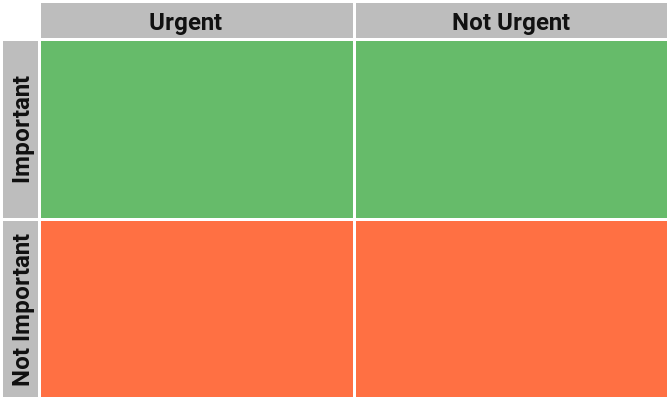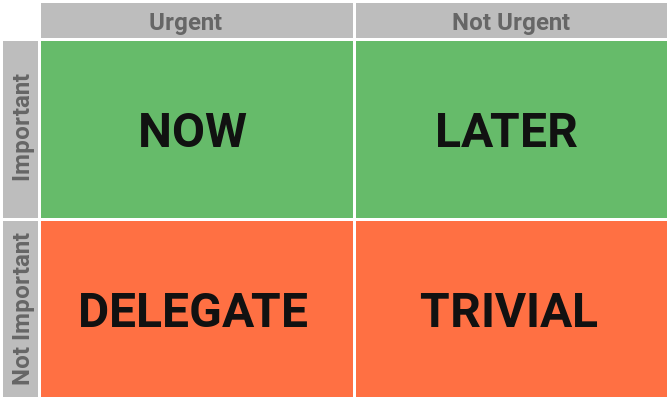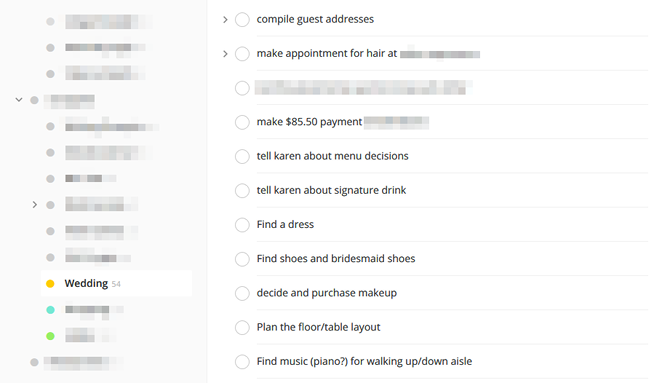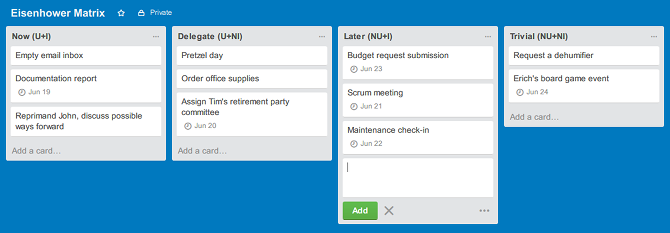To-do list apps are all the rage these days. Science has proven that lists really do encourage productivity, and you can further boost productivity using tricks like making your to-do list public. Some people even use their email inboxes as to-do lists.
But what if you've tried all that and none of it works?
Lucky for you, alternative productivity methods exist. And if you find that regular to-do lists are too troublesome or too overwhelming, then we recommend trying an old-but-effective technique called the Eisenhower Matrix.
What Is the Eisenhower Matrix?
The Eisenhower Matrix is a 2x2 grid of boxes. The top row is for tasks that are "Important" while the bottom row is for tasks that are "Not Important." At the same time, the left column is for tasks that are "Urgent" while the right row is for tasks that are "Not Urgent." Here's what that looks like:
To most people, the terms Important and Urgent are synonymous, so let's take a moment to define the difference between them:
- Important -- Tasks that contribute to your long-term goals and values, whether personal, professional, etc. Importance is all about relevance. One way to decide if a task is important is to ask yourself: "Can I still reach my goals and stay true to my values if I skip this task?"
- Urgent -- Tasks that need to be handled by the end of the day. If your schedule has more leeway, you may prefer by the end of the week. Either way, urgency is all about time. One way to decide if a task is urgent is to ask yourself: "When is the deadline for this task?"
Before you can decide whether a task is important or not, you need to know your own goals and values. For many, career progression is a long-term goal, so tasks directly related to that are important. Or if you value family most, then getting home on time may be important.
But how can a task be urgent yet not important? Remember that urgency is only about time. Think of the deadline. Suppose today is International Coffee Day and your local coffee shop is giving out free coffees. If you don't take advantage of that today, the opportunity is lost -- but free coffee has no relevance to your long-term goals or values. It's urgent, but not important.
Using these definitions, it becomes easier to describe the kinds of tasks that belong in each of the four boxes. We can even think of the matrix in this way:
Why Use the Eisenhower Matrix?
The Eisenhower Matrix is simply a way to prioritize your tasks.
To-do lists are great at tracking what you need to do, but it's not always easy to determine which tasks have higher priority. I've personally never used the "Priority" feature in any to-do list app because I always end up tagging everything as "High Priority" -- and when everything is high priority, nothing is.
Furthermore, when you look at a to-do list and see 30 piled up tasks, how do you decide which task to tackle? "Start with the easiest," some say. "No, start with the hardest," others say. But what's easy and what's hard? It's never black and white. Often times, I've wasted 10, 15, or even 30 minutes just trying to pick my task!
This is why the Eisenhower Matrix shines. Unlike a single to-do list, the matrix is self-prioritizing. It tells you which task to handle next. It lessens cognitive load because only the Now and Later boxes truly matter. And if you're ever crunched for time, it helps you see which tasks you can skip.
In addition, the matrix has two other minor benefits. First, it forces you to be more mindful of each task. Instead of throwing everything into one big messy to-do pile, you actively decide if tasks are worth your time up front, keeping your actual to-do list tight. Second, it constantly reminds you of your goals and values.
The only problem is that the Eisenhower Matrix can be a bit tricky at first. In particular, new users tend to get tripped up by the Delegate and Trivial boxes. There is a learning curve, so let's go through a practical example of how to set up a matrix, organize tasks, and get through one day.
How to Use the Eisenhower Matrix
Even though the Eisenhower Matrix is conceptually a square of four boxes, you can practically approach it as four separate to-do lists: a Now list, a Delegate list, a Later list, and a Trivial list. The two urgent lists come before the non-urgent lists.
I find that Trello is awesome for this. Set up a board for each sphere of your life (e.g. personal, professional, church, hobby) and set up these four lists in each of the boards. Or if you don't have much going on, you could use one board for all tasks. It's up to you. Don't like Trello? Consider these alternative Kanban tools.
Once your lists are ready, you can start adding tasks:
Let's say you're a traditional office worker who wants to use the Eisenhower Matrix to become more productive at work. This will be the scenario that drives the rest of this example, but it should be easy to apply these concepts otherwise.
What's on your plate for today? First thing that comes to mind: email. Let's create a task for reaching inbox zero, which is urgent (email should be emptied daily) and important (we're talking work-related emails here):
Today happens to be Pretzel Day at the office and you're craving a free pretzel with the works. This might be urgent, but it's not important:
Your boss reminds you that the documentation report for your team's last project is due by 4 PM, which is both urgent and important:
He also reminds you that your team's budget request for your next project is due by end-of-day on Friday. This is important, but not urgent:
The office manager comes to you and says that paper and ink supplies are running low. You need to place an order as soon as you can -- but this doesn't have much to do with your careers goals or values:
It's early summer (in this scenario) and the office is getting too muggy with the wet season. Everyone's productivity would skyrocket with a good dehumidifier, not to mention all the other benefits of reducing humidity.
You make a note to bring this up, but it's neither urgent nor important:
On and on it goes. Meetings crop up, planning needs to be done, you remember things that you want to do, etc. Eventually, your matrix (i.e. lists) will fill up, and the best part is that it's way less intimidating than one master list of tasks:
Whenever you're free for another task, simply start at the left and move right. You should tackle everything in the Now and Delegate lists before concerning yourself with the non-urgent lists.
If you can delegate, tackle the Delegate list first and offload as many of those tasks as you can. Then go through the Now list. Once you get through the Now list, consider your day a success. You can now get a head start on the Later list or end the day early.
If you can't delegate, start with the Now list. If you get through the Now list and you have more time, you have a choice: treat the Delegate list as a Now list, get a head start on the Later list, or end the day early. In practice, you'll probably want to alternate between Delegate and Later tasks.
At day's end, go through the Delegate list and dump all tasks whose deadlines have passed. Keep the ones you can still do. Save them for tomorrow.
At the start of the next day, go through the Later list and decide which tasks are now urgent. Shift them into the Now list. Do the same for the Trivial list, except shift those tasks into the Delegate list. Add any new tasks that crop up throughout the day. Rinse and repeat.
When To-Do Lists Don't Work for You
Note that you can modify the Eisenhower Matrix however you want. For example, instead of using it to guide your entire day, you can sort your email with its own matrix. The whole concept of urgency/importance can prove useful in all kinds of cases beyond work and email.
A lot of people have found great success with the Eisenhower Matrix. But if you've reached this point and you don't think it'll help, that's okay. Keep looking for the method that works for you. When all is said and done, the only productivity technique that matters is the one you actually use.
Do you find the Eisenhower Matrix helpful? If not, what productivity technique do you use to stay organized and ahead? Share with us in the comments below!
Image Credit: Amy Bull via Shutterstock.com












